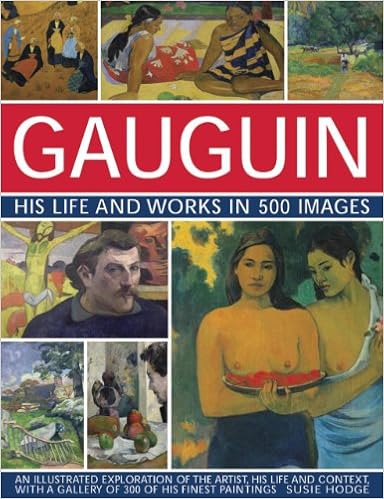Paul Gauguin (7 June 1848 – 8 May 1903) was born in Paris, France in 1848, and became a leading post-impressionist painter who developed a new style which fused impressionism with a more avant-garde style.

Initially, Gauguin was interested in impressionism, but increasingly he felt it was stilted and artists were merely imitating each other. He became increasingly interested in African and Asian art. He felt this captured a greater symbolism and hidden meaning. In 1887, he spent time in Martinique, where he lived in a primitive hut becoming immersed in the local culture.
In 1888, he spent nine weeks painting in Arles, with his friend Vincent Van Gogh. They both had a great mutual respect, however, being of a similar temperament, they had a volatile relationship. Both suffered from periods of depression and manic mood swings. Despite a great mutual appreciation, they also had fierce arguments. This period proved productive for both artists.
Early art career

The Yellow Christ – 1889
The Yellow Christ (1889), is an example of a Cloisonnist work; the image is simplified to stark areas of pure colour. It was a sharp contrast to the gradual colour change of classical post-renaissance art. Despite impressing some fellow artists, his bold work did not find favour, and Gauguin struggled to gain any significant financial rewards. In 1891, he sailed to the tropics, looking for a tropical paradise where he would be free to live a simple life and paint.
Gauguin became a great supporter of the local Polynesian natives. He sided them with over disputes with Colonial powers and the Catholic church. During this period he wrote short essays about Martinique and Polynesia.
Gauguin died on May 8, 1903, from complications resulting from syphilis and is buried in Calvary Cemetery (Cimetière Calvaire), Atuona, Hiva ‘Oa, Marquesas Islands, French Polynesia.
Citation: Pettinger, Tejvan. “Paul Gauguin Biography”, Oxford, UK. biographyonline.net, 18th April 2014. Last updated 22 Feb 2018.
Paul Gauguin
Gauguin: His Life & Works in 500 Images: at Amazon
Related
 Artists – A list of the great artists, including Leonardo da Vinci, Claude Monet, Vincent Van Gogh, Pablo Picasso, Michelangelo and Rembrandt.
Artists – A list of the great artists, including Leonardo da Vinci, Claude Monet, Vincent Van Gogh, Pablo Picasso, Michelangelo and Rembrandt.





